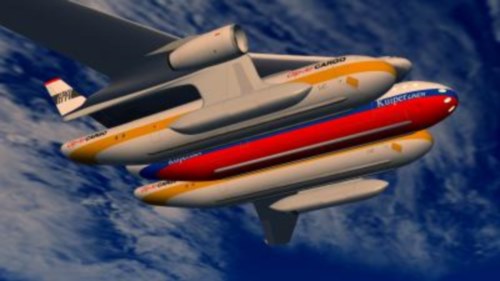Imagine boarding a train en route to the airport. When you arrive, you would never have to leave the train. Instead, your train car will acquire some wings and turn into a plane, taking you wherever your flight is headed.
Sounds a bit futuristic, but a group of researchers from EPFL, one of the two Swiss Federal Institutes of Technology in Switzerland, has spent four years working on a project that could potentially combine the transportation methods of trains and airplanes.
EPFL has been working on their vision to create a modular aircraft with a flying wing that can be attached to multiple autonomous train capsules.

A Clip-Air aircraft carrying tow cargo and one passenger capsules. (Image via EPFL)
The “Clip-Air” project proposal can customize a plane on demand.
“For example, one can attach only first or second class modules. This could have an important consequence on transportation. Modularity would allow planes to come out of airports to the very center of our cities or even industries,” said Claudio Leonardi, head of the Clip-Air project.
The carts would be around 100 feet long, weigh 30 tons, be compatible with railroad tracks, and be able to fit into an airport at which time up to three of the carts (holding up to 150 passengers in each) could be attached to a wing and embark on their flight.
The Clip-Air plane would still have its wing, engines, cockpit, fuel, and landing gear, but the cars attached would act as a real plane’s fuselage.
Why flying trains?
The EPFL team is thinking about making the transportation of tomorrow more flexible, more efficient, and less energy-consuming. The team’s studies have shown that the concept has the potential to create flexible fleet management and to diminish empty flights.
The main contribution if the project was successful would be providing the flexibility of railroad transportation to air transportation.
Clip-Air also addresses the negative impact airplanes have on the environment by trying to reduce CO2 emissions by 50% by the year 2020. If this concept was brought to life, it would reduce fuel consumption by carrying more passengers than a typical airbus. (The team reports that it can carry the same amount of passengers as three A320 planes.)
They are also looking into using other methods of fuel such as liquid hydrogen and biofuels that are less polluting than what is currently available.
Check out the simulation in the video below to get a better idea of what this transportation method would look like.
Video via EPFL.
Is it possible?
The Clip-Air team knows that they have proposed an idea that may be ahead of its time, but scientists working on the project say that it is technically feasible.
“We still have to break down several barriers but we do believe that it is worth to work in such a concept, at odds with current aircraft technology and which can have a huge impact on society,” said Leonardi.
They are currently performing more advanced aerodynamic simulation and testing a 20-foot-long train/plane model that is powered by mini-reactors in order to explore the concept further.
In the meantime, a 4-foot model of the Clip-Air plane will be presented for the first time at the Normandy Aerospace stand at the Paris Air Show from June 17 to 19. So if you happen to be in France, you can check it out for yourself.
Advertisement
Learn more about Electronic Products Magazine





